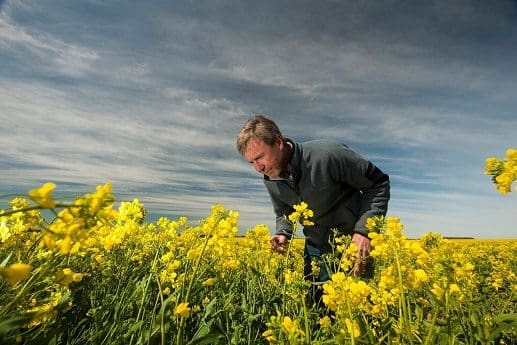THE latest blackleg ratings for canola cultivars have been made available to the nation’s grain growers.

Marcroft Grains Pathology principal Dr Steve Marcroft says results from the latest blackleg screenings of canola cultivars have been factored into the updated disease ratings for 2018. (Photo: B. Collis)
Marcroft Grains Pathology principal Dr Steve Marcroft, who is co-ordinator of the GRDC’s National Canola Pathology Program investment, said results from the latest blackleg screenings of canola cultivars had been factored into the updated blackleg ratings for 2018.
“Blackleg ratings can change from year to year if the fungus overcomes cultivar resistance, so it is important growers refer to the latest ratings when planning their cropping programs,” Dr Marcroft says.
Leptosphaeria maculans, the causal agent of blackleg disease, is a sexually reproducing pathogen that may overcome cultivar resistance genes.
Fungal spores are released from canola stubble and spread extensively via wind and rain splash.
The impact is more severe in areas of intensive canola production.
“Blackleg can cause severe yield loss, but can be successfully managed,” Dr Marcroft said.
“Growers are therefore advised to closely follow the recommended strategies for reducing the risk of disease which are contained in the GRDC Blackleg Management Guide.”
The guide can be used by growers to determine whether they are in a high-risk situation and what practices they can change to reduce or prevent yield loss from blackleg. These practices include:
- Never sowing your canola crop into last year’s canola stubble;
- Avoid sowing your canola crop adjacent to last year’s canola stubble;
- Choosing a cultivar with adequate blackleg resistance for your region;
- Only using fungicides if there is a high probability of yield loss, ie sowing next to last year’s canola stubble and/or sowing a cultivar with a low blackleg rating. Relying only on fungicides to control blackleg poses a risk of fungicide resistance;
- If your monitoring has identified yield loss and you have grown the same cultivar for three years or more, choose a cultivar from a different resistance group;
- Monitor your crops in spring to determine yield losses in the current crop.
The new BlacklegCM blackleg management app has also been updated with the latest disease ratings.
The app, a GRDC investment, provides growers with a tool that can forecast the likelihood and severity of the disease, associated yield loss and economic returns on a paddock-by-paddock basis ahead of sowing.
Dr Marcroft said the tool provided growers and advisers with “an interactive interface” to explore and compare the economic outcomes of different management strategies for blackleg, which could cause up to 90 per cent yield loss where a cultivar’s blackleg resistance had been overcome.
The app, available for use on tablets via the App Store and Play Store, is an extension of the Blackleg Management Guide which is updated twice a year to reflect any changes in the resistance status of individual cultivars.
“BlacklegCM assists growers to manage blackleg by integrating the information provided in the Blackleg Management Guide and producing a predicted economic outcome,” Dr Marcroft said.
“It can be modified to account for some of the major factors that relate to risk of yield loss due to blackleg in a particular paddock. It allows the user to compare the likely relative profitability of different disease management strategies, including paddock selection, cultivar choice, seed dressing, banded fungicide and sprayed fungicide.”
BlacklegCM takes account of costs, yield benefits and grain prices to give the best case, worst case and most likely estimates of economic return. It also accounts for the major factors that influence blackleg severity and can also be used during the growing season to assist in making foliar fungicide application decisions.
Dr Marcroft said the severity of disease in 2018 will be dependent on seasonal conditions.
To further assist growers in determining the level of risk in their area, the GRDC-supported National Variety Trials (NVT) Online website, https://www.nvtonline.com.au, provides the latest information from blackleg monitoring sites across Australia.
Representative cultivars from all blackleg resistance groups are sown in trial sites in all canola-producing regions and monitored for blackleg severity. This data provides regional information on the effectiveness of each blackleg resistance group.
Source: GRDC
Grain Central: Get our free daily cropping news straight to your inbox – Click here

HAVE YOUR SAY